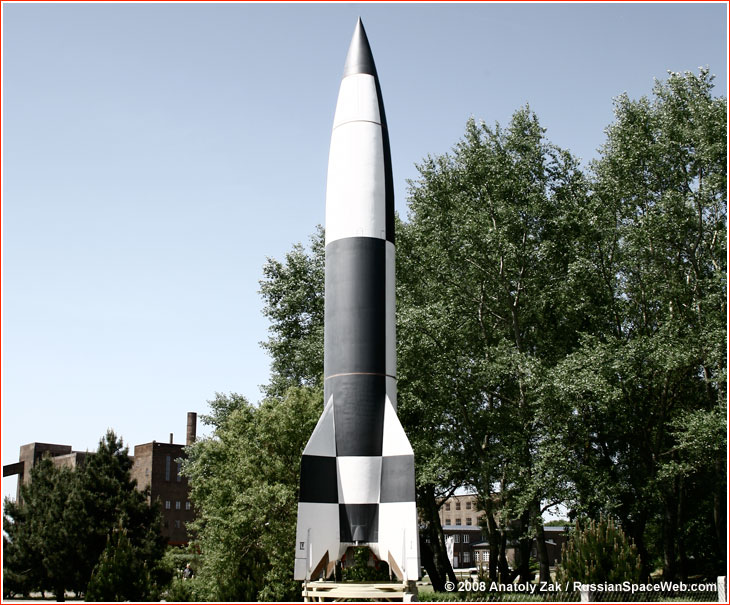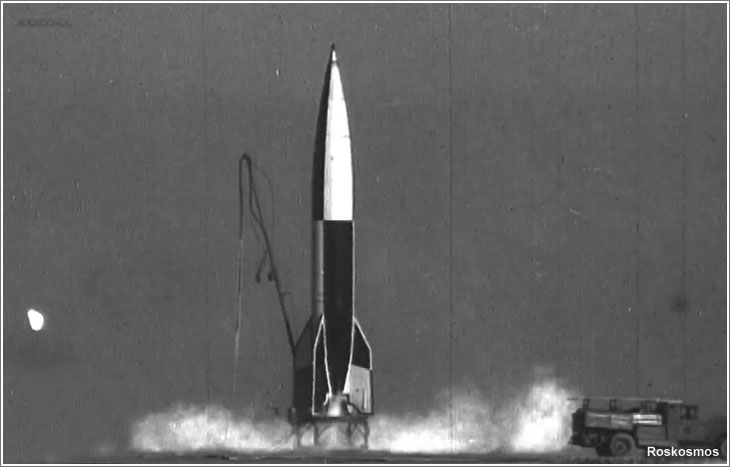The A-4 (V-2) ballistic missile (original) (raw)
The A-4 (V-2) ballistic missile
During World War II, the Nazi regime in Germany funded an unprecedented effort to build rocket weapons. Capitalizing on the experience accumulated by German rocket enthusiasts since the second half of the 1920s, a group of engineers at a secret center in Peenemünde developed a ballistic missile of incomparable size and range. Officially dubbed Vergeltungswaffe-2, or "vengeance weapon-2," the cigar-shaped rocket could reach targets some 300 kilometers away. (169)
Previous chapter: The A-3 rocket

Known specifications of the A-4 (V-2) rocket:
| Length | 14.03 meters |
|---|---|
| Maximum diameter: | 1.68 meters |
| Launch weight: | 12,870 kilograms |
| Engine burn time: | 70 seconds |
| Maximum speed: | 5,760 kilometers per hour |
| Maximum speed at impact on target: | 800 meters per second |
| Maximum range: | 330 kilometers |
| Maximum altitude: | 96 kilometers |
| Engine thrust on the surface: | 26 tons |
| Engine thrust at high altitude: | 30 tons |
| Warhead mass: | 900 - 1,000 kilograms |
| Fuel mass (alcohol): | 3.6 tons |
| Oxidizer mass (liquid oxygen): | 5 tons |
The V-2 rocket, originally named A-4, grew out of several previous projects conducted in Kummersdorf and later in Peenemünde, including the A-3 experimental rocket with an estimated range of 50 kilometers.
The first (unsuccessful) test launch of the A-4 rocket took place at June 13, 1942, at 10:52 GMT in Peenemünde. It was followed by another aborted flight on August 16 and a largely successful flight to an altitude of 85 kilometers on Oct. 3, 1942.
Starting on Sept. 5, 1944, the missile was used by the German Army to attack England and a number of allied targets in Europe. The last German A-4 rocket was launched from Peenemünde on Feb. 19, 1945. Despite all the terror and devastation the A-4 had brought to the civilian population, its effect on the outcome of the war was minimal. It became a historical cliche that more people died producing V-2s under terrible conditions of the Nazi slave-labor system than from explosions of their warheads. Some even claimed that had Nazis invested the resources and talent dedicated to the A-4 project into conventional weapons, World War II would last longer.
Still, the allies looked carefully at the German rocket program. After the war, the British military with the help of German specialists launched three A-4 rockets from Germany in an effort to learn about the weapon and better estimate its capabilities. Apparently, most surviving A-4 rockets were captured by the US forces and were transported to the United States where they were launched from a test range near White Sands, New Mexico.

A total of 11 A-4s, mostly fashioned from spare parts and newly produced components were also launched from Kapustin Yar by a Soviet-German team in the Fall of 1947. Finally, the A-4 became a basis for a Soviet-built copy, designated R-1 and the subsequent long-range ballistic missile development program in the USSR.
Next chapter: Search for the A-4 rocket technology in Poland
Writing and photography: Anatoly Zak; Last update:September 4, 2024
Page editor: Alain Chabot; Last edit: October 12, 2008
All rights reserved
